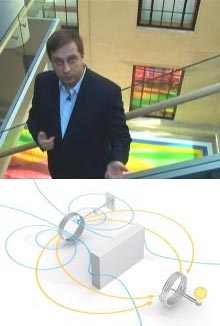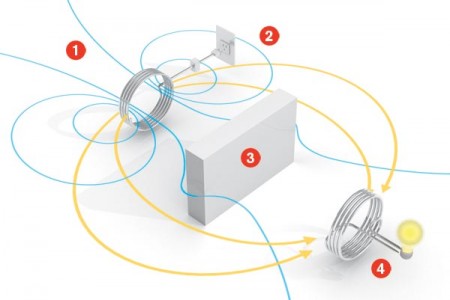Energy without wires. Towards a new world of wireless electricity
 At the end of the 19th century, the discovery that a light bulb could be made to glow with electricity caused an explosion of research aimed at finding the best way to transmit electricity. At the head of the race was the famous physicist and inventor Nikola Tesla, who developed a grandiose project. Unable to believe in the reality of creating a colossal network of wires covering all cities, streets, buildings and rooms, Tesla came to the conclusion that the only way to transmit is wireless. He designed a tower about 57 meters high, which was supposed to transmit energy for many kilometers, and even began to build it on Long Island. A number of experiments were carried out, but the lack of money did not allow the tower to be completed. The idea of transmitting energy through the air dissipated as soon as it turned out that the industry was able to develop and implement a wired infrastructure.
At the end of the 19th century, the discovery that a light bulb could be made to glow with electricity caused an explosion of research aimed at finding the best way to transmit electricity. At the head of the race was the famous physicist and inventor Nikola Tesla, who developed a grandiose project. Unable to believe in the reality of creating a colossal network of wires covering all cities, streets, buildings and rooms, Tesla came to the conclusion that the only way to transmit is wireless. He designed a tower about 57 meters high, which was supposed to transmit energy for many kilometers, and even began to build it on Long Island. A number of experiments were carried out, but the lack of money did not allow the tower to be completed. The idea of transmitting energy through the air dissipated as soon as it turned out that the industry was able to develop and implement a wired infrastructure.And now, a few years ago, Marin Soljačić, an associate professor at the Department of Physics at the Massachusetts Institute of Technology (MIT), was awakened from sweet sleep by the persistent picking of a mobile phone. “The phone did not stop talking, demanding that I set it to charge,” says Soldzhachich. Tired and unable to get up, he began to dream that the phone, once at home, would start charging by itself.
Soldjacic took up the study of ways to transmit energy without wires. He abandoned long-distance power transmission projects like the Tesla project and focused on short-range power transmission methods that would allow charging or even turning on portable devices - mobile phones, PDAs, laptops.
')
At first he considered the possibility of using radio waves, which transmit information so effectively at a distance, but found that in this case most of the energy will be dissipated in space. The use of a laser required that the energy source and the rechargeable device be in sight of each other without any obstacles between them. In addition, this method was fraught with damage to objects that were on the transmission line. Therefore, Soldzhachich began to look for a transmission method that would be both efficient, that is, capable of transmitting energy without dissipating it, and is safe.
In the end, he stopped at the phenomenon of resonance coupling, when two objects tuned to the same frequency intensively exchange energy with each other, while only weakly interacting with other objects. A classic illustration of this effect is the experience with several glasses filled with wine, each up to its own different level. As a result, for each glass there is a unique frequency of sound that causes vibration. If the singer takes a note of the appropriate frequency, one of the glasses can receive such a dose of acoustic energy that it will scatter, while the other glasses will remain intact.
Soldjacic realized that magnetic resonance is a promising way of transmitting electricity. The magnetic field propagates freely in space and, with properly chosen frequencies, is harmless to living beings. Working together with the physics professors of MIT, John Joannopoulos and Peter Fisher, and three students, he developed a simple device that turned on a 60-watt light bulb without wires.
The device consisted of two resonant copper coils suspended from the ceiling at a distance of about two meters. One coil was connected to an AC power source and created a magnetic field. A second coil tuned to the same frequency and connected to a light bulb, resonating in a magnetic field, generated a current that ignites the light bulb. The device worked even when a thin wall was placed between the coils.
The most effective of the devices created at this time consists of 60-centimeter copper coils and a magnetic field with a frequency of 10 megahertz. It allows you to transfer energy over a distance of two meters with a 50 percent efficiency. Research is being conducted with silver and other materials in order to reduce the size of the coils and increase efficiency. Soldjacic hopes to achieve 70-80 percent transmission efficiency.

A number of other ways to recharge batteries wirelessly are currently being investigated. Startups such as Powercast, Fulton Innovation, and WildCharge have begun to market adapters that allow wireless charging of mobile phones, MP3 players and other devices at home or in the car. But the approach Soldzachich differs in that it allows you to provide automatic charging devices, as soon as they fall into the field of action of the wireless transmitter.
The work of the Soljacic group attracted the attention of companies producing electronic devices, as well as the automotive industry. The research was funded by the Department of Defense of the USA, who hoped to get the technology of wireless automatic charging of batteries. However Soljacic prefers not to spread about the possible industrial application of his technology.
In today's battery-driven world, there are so many potential applications where our technology can be used, ”he says.“ This is a very powerful method. ”
Source: https://habr.com/ru/post/31503/
All Articles